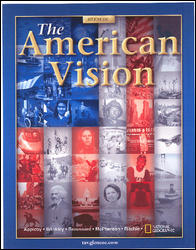

The American VisionChapter 3: Colonial Ways of Life, 1607–1763Chapter OverviewsThis chapter focuses on how the different economies of the northern and southern colonies influenced their lifestyles and populations. Section 1 discusses how the Southern colonies developed agricultural economies that relied heavily upon enslaved labor. Favorable growing conditions helped Southern colonists to establish self-sufficient plantations. Their cash crops—tobacco, rice, and indigo—required intensive manual labor. At first, indentured servants were used for the backbreaking work, but slavery soon made its way into the colonies. The plantation system kept the colonies' wealth and political power in the hands of a wealthy elite, while a large, enslaved African population labored in the fields. This imbalance of power was tested when a rebellion in Virginia took up the cause of poor backcountry farmers who wanted to settle land claimed by Native Americans. In order to keep Virginia society stable, the wealthy elite responded to the rebellion by expanding settlement westward. At the same time they increased their use of enslaved Africans. The slave trade captured and forcibly transported millions of Africans to the Americas. By the early 1700s, slavery was commonplace in the colonies, and enslaved Africans found their status and rights restricted by slave codes. Section 2 explores the economies and societies of New England and the Middle Colonies. New England's geography helped the colonists develop thriving fishing, whaling, logging, and shipbuilding industries. Puritan beliefs guided colonists' behavior and encouraged them to develop towns—the heart of New England society. Town meetings formed the basis for the local town government and fostered New Englanders' strong belief in the right to self-government. New England's industries and fine ports encouraged some settlers to become merchants. The triangular trade systems helped colonists exchange their products for English goods. As trade expanded, cities formed, and social classes emerged in New England and the Middle Colonies. The fertile land of the Middle Colonies allowed colonists to cultivate an important cash crop—wheat. Wheat was in high demand, and the colonies' wide rivers helped farmers move their crops to the coast. Trade centers along the rivers grew into prosperous towns. Section 3 describes how England's mercantilist policies and the Glorious Revolution impacted the American colonies. The king tried to generate wealth in England by controlling manufacturing and trade in America. The Navigation Acts prevented the colonies from selling goods to other nations, taxed trade within the colonies, and instituted other restrictions. When customs officials found colonists smuggling, the king revoked the charters of Massachusetts, Connecticut, and Rhode Island and appointed an unpopular royal governor. Troubles in England led to the Glorious Revolution, and a new king and queen allowed Rhode Island and Connecticut to resume their previous governments. Massachusetts, however, became a royal, and more tolerant, colony. England's revolution and the writings of philosopher John Locke introduced Americans to the idea that there are times when revolution is justified. Section 4 follows the maturing of America into a productive, diverse society. During the 1700s, a high birthrate, a flood of immigrants, and the slave trade created a population explosion in the colonies. Immigrants from Europe sought religious or economic refuge and included German Mennonites, Scotch-Irish, and Jews. Enslaved Africans were forcibly brought to the colonies to work on the Southern plantations. They used various methods to resist planters' brutal treatment and developed a new culture that combined traditional African languages, religions, and music with English elements and the Christian faith. While the colonial population increased, the Enlightenment and the Great Awakening influenced colonial thought and caused many Americans to question traditional authority. |  |















